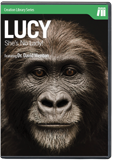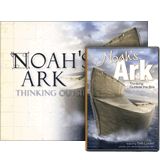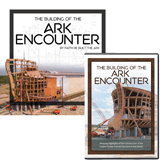Stunning Exhibit Unveiled at Creation Museum
New High-tech Display Opens on Museum’s Fifth Anniversary
Using the latest in holographic technology, the Creation Museum, as a part of its fifth anniversary celebration, has opened a new high-tech exhibit on human origins last Saturday.
Editor’s note: This article was adapted from a news release that was recently distributed to the media.
Using the latest in holographic technology, the Creation Museum, as a part of its fifth anniversary celebration, has opened a new high-tech exhibit on human origins last Saturday. With striking holograms, this state-of-the-art exhibit is designed to expose the scientific bankruptcy of the evolutionary interpretation of the famous so-called ape-woman “Lucy.”

Perhaps more than any other fossil, Lucy is presented as “exhibit A” for evolutionists in their attempt to show that humans evolved from an ape-like ancestor. Through the scientific research of the Creation Museum’s Dr. David Menton (PhD, biology, Brown University) and the artistic talents of Doug Henderson and his crew, the museum has created a stunning holographic refutation of Lucy. (The technical name for this Lucy creature found in Africa is Australopithecus afarensis.)
“I expect that scientists, both evolutionists and creationists, will make a trip to the Creation Museum to see this exceptional exhibit, not only because it refutes Lucy as an ancestor of ours, but also due to its use of remarkable holographic technology,” declared Ken Ham, Founding CEO of Answers in Genesis and the museum.
In a highly visual way, the exhibit conclusively shows that the fossil bones of Lucy belong to a knuckle-walking, ape-like creature. Menton points out that many evolutionists such as the well-known researcher Donald Johanson, the discoverer of “Lucy,” admit that Lucy’s V-shaped mandible was very ape-like, nothing like that of a human. In addition, Israeli scientists reported in the Proceedings of the National Academy of Science that it may not be our ancestor, for its lower jaw bone resembles a gorilla’s.
In the new museum exhibit, a number of Lucy heads have been created, cast from the same mold. Each head, however, is given different skin and eye coloration, as well as variations in the amount and color of hair. This was done to demonstrate how significant artistic license can be employed by researchers in interpreting what Lucy resembled as they “put flesh to the bones” of the creature. There simply isn’t enough information found in the fossil bones for anyone to determine what Lucy looked like.
“An imagination-rich artist can have a very powerful influence over what the viewer concludes about the evidence presented,” Menton observed. “That is one reason why our Lucy exhibit is placed in an area of the museum that demonstrates to visitors that a person’s starting point, or bias, influences their views.”
“Ultimately, with this excellent display, we want to show museum guests, once and for all, that this knuckle-walking creature needs to be discarded as a ‘missing link’ in human evolution,” Menton concluded.
Holographers tell us this is the first time they have seen holography used to take a virtual ‘look inside’ a creature for the public to view.
Designer Henderson described the technology used in the exhibit, “We have used holograms of the actual bone models of Lucy, as opposed to simply exhibiting a 3D physical model. Holographers tell us this is the first time they have seen holography used to take a virtual ‘look inside’ a creature for the public to view. I call it a 3D X-ray.”
Every few months, the Creation Museum (located west of the Cincinnati Airport) adds new exhibits to present the case for the Bible’s authority and accuracy, including creation. Last year, Menton’s striking exhibit on homology—comparing humans to apes (and to other creatures)—used the technology of lasers to point out the differences between humans and animals. Menton’s latest exhibit may create even more of a stir in the origins debate, for Lucy is treated with near reverence by some scientists.
As the Creation Museum celebrates its fifth anniversary, almost 1.6 million visitors have walked through its 75,000 square feet of exhibits. Additional exhibits are in the works for year six. Last month, the Johnson Observatory opened, with two high-power telescopes. Also, virtually the same artistic team that built the Creation Museum is now busy designing a full-size Noah’s Ark for the Ark Encounter, to be built south of Cincinnati.
The museum opened May 28, 2007, with more than 4,000 people on opening day. The museum averages over 300,000 guests a year (about 800 visitors per day).
Beginning Friday, May 25, just in time for the fifth anniversary festivities, all museum tickets are now good for two days. The museum has instituted this new policy in response to visitor feedback that with so many additions to the museum, there is a lot to take in in one day. Current pricing will remain in effect through June 2, with prices increasing slightly on June 3 to $29.95 for adults, $23.95 for seniors and $15.95 for children ages 5–12 (under 5 is free).
Answers in Genesis is a biblical apologetics ministry. AnswersInGenesis.org is this year’s “Best Ministry Website” as picked by the 1,200-member National Religious Broadcasters (with over 1 million web visits a month). AiG’s Answers magazine, for the second year in a row, recently took the top prize for magazine excellence as selected by the Evangelical Press Association. AiG conducts about 300 teaching meetings each year and produces the Answers radio program heard on more than 500 stations. For information, including about the all-wood Ark, see AnswersInGenesis.org.
Recommended Resources

Answers in Genesis is an apologetics ministry, dedicated to helping Christians defend their faith and proclaim the good news of Jesus Christ.
- Customer Service 800.778.3390
- © 2024 Answers in Genesis







